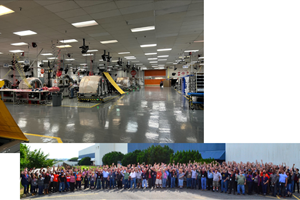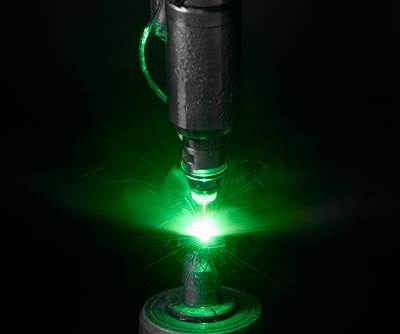Laser cleaning in composites manufacturing
Laser cleaning technologies for cleaning production molds for composites offer alternatives to harsher, less-friendly methods with features like automation and higher power cleaning.
Gantry laser cleaning system used in composite manufacturing. Source (All Images) | Loop Technology
Laser cleaning systems are increasingly being used by composites part manufacturers to clean production molds, offering increased efficiency and reduced cost while also improving the environmental impact and worker conditions for these companies.
Composite molding tools come in a large range of sizes and geometries and are made from various materials including steel, aluminum and Invar. Traditionally, molds have been cleaned using manual abrasive methods, media blasting or chemicals, but these techniques introduce their own challenges. Abrasive cleaning, for example, may create dust and volatiles, negatively impacting employee health. It also can result in the degradation of the mold’s surface, premature wear and potential for residue buildup. Meanwhile, media blasting or use of chemicals are both harsh and aggressive procedures that risk damaging the mold over time and changing its shape.
Laser cleaning presents an alternative that uses high-energy light pulses to remove resins, production residues, release agents, oxides, oils and other unwanted substances with a high degree of accuracy. This technique ensures that the underlying substrate isn’t damaged and, consequently, significantly extends the lifecycle of the mold. Loop Technology (Dorchester, Bristol and Sheffield in U.K.) is a specialist that integrates laser cleaning with robots and gantry systems, notes that there are already a variety of solutions available on the market that support industry cleaning needs. Automated laser cleaning systems, for example, can decontaminate very large structures with complex surface profiles at rates of up to 22 square meters/hour for certain applications. Laser cleaning can also be used for preparing carbon fiber-reinforced polymer (CFRP) panels for adhesive bonding or various part surfaces for nondestructive testing purposes.
Fundamentals of laser cleaning
Laser cleaning an aerospace mold tool made from Invar used in composites manufacturing.
Laser cleaning uses ablation to remove material from the designated surface. Nanosecond-length pulses of laser light are directed toward the target material. By precisely controlling laser parameters such as wavelength, pulse duration and energy intensity, the unwanted material or residue is sublimated and removed without damaging the underlying structure. The process combines thermal ablation, photolytic degradation and shock waves. Because different materials absorb laser energy at different levels, laser parameters are adjusted according to the mold tool material.
There are two distinct modes of operation for laser cleaning systems. Pulsed laser cleaners emit laser energy in short, distinct bursts or pulses. Each pulse has a specific duration and is separated by periods of no emission. This is ideal for precision- or shock-based cleaning tasks like removing thin films and residue from a substrate that needs to be preserved. Alternatively, continuous wave lasers emit a steady, uninterrupted beam of light, ideal for heavy-duty cleaning tasks like removing rust, paint and other coatings from metal tools.
Many different types of lasers have evolved over the decades including ruby and neodymium-doped yttrium aluminum garnet (Nd:YAG) crystal-based designs, CO2 gas models and solid-state, fiber-based laser designs. The latter has become especially popular with manufacturers generally.
The evolution of laser cleaning
The invention of the laser itself dates back to 1960 when Theodore H. Maiman demonstrated the first working ruby laser at Hughes Research Laboratories in the U.S, building upon work from the preceding decades including from Albert Einstein on stimulated emission in 1917. Another significant milestone occurred in 1972 when John Asmus, who was experimenting with a pulsed ruby laser for analysis of the surface of a statue, discovered its additional potential as a cleaning application. Pulsed ruby lasers were the most common type used for cleaning in these very early years, done mostly in a research setting.
As the field progressed, other types of lasers were introduced such as Nd:YAG lasers, which produce light typically at a wavelength of 1,064 nanometers. Q-switched ND:YAG lasers — a distinct technique that modulates the laser cavity’s ability to store and release energy — directs short, high-power energy pulses at a surface and are used today for cleaning small, delicate molds or removing residue from circuit boards. Gas lasers followed soon after in the 1990s. For example, CO2 lasers use a mix of CO2, nitrogen and helium gas to create a powerful, focused beam of infrared light that can remove paint, grease and rust. However, they were later superseded by technology that proved more suitable for decontamination.
The most recent of these are solid-state fiber lasers that use a thin, flexible optical fiber doped with rare-earth elements such as ytterbium, erbium or neodymium. Fiber lasers are considered to be a popular choice for cleaning tasks in composites manufacturing because of their comparative efficiency, versatility, compactness and long life. Continuous fiber lasers are often chosen for large-scale jobs like stripping paint and coatings from big marine structures in preparation for inspection or refurbishment and for cleaning sizable molds and machinery at manufacturing plants. These pulsed lasers are ideal for removing material accurately, not only for inspection and NDT preparation, but also for gentle cleaning.
Technologies for a range of mold cleaning needs
Laser cleaning’s ability to clean metals, plastics and composites with precision have propelled its widespread adoption across industrial manufacturing. In addition, increasing demand for high-power laser cleaning systems, a shift toward eco-friendly and nondestructive cleaning methods and hybrid processing technology has given rise to more automated solutions. This is where Loop Technology has contributed to further development.
“Building on its experience in composites, automation and laser cleaning, Loop Technology is continuously optimizing its range of laser cleaning and systems services according to industry needs and evolving technology,” says Tom Turner, marketing executive at Loop Technology.
One example is FibreLINE, which can include laser cleaning. The system is a high-rate automated end-to-end composite preforming solution. It delivers cutting, sorting, picking, forming, placing, consolidation and inspection of large dry carbon fiber plies and other composite materials — up to 20 meters in length — and is made possible via a suite of end effectors. It is available with automated laser cleaning for decontaminating molds after demolding composite parts, adding another level of efficiency to the process.
This gantry laser cleaning system is ideal for decontaminating large-scale structures.
Another example is the CleanLASER range, which features several models — low-power units (12-100 watts) up to the high-power CL 1000 and CL 2000 models for treating large areas and thicker materials. Whether for small- or large-scale mold cleaning, the CleanLASER range is suitable for many applications and there are also extraction systems available for removing the waste and debris. For instance, the 300-, 500- and 1,000-watt units can all be used to clean tire molds at high speed, often within 30 minutes. The accuracy they offer enables the user to safely clean microspring vents and ensure debris does not go into the mold vent holes, a challenge that can occur with media blasting and other manual cleaning methods.
Automated laser cleaning cells include the LoopCLEAN product line with three levels of automation. In the standard model, the operator programs the robot and controls its range of motion through a pendant. The Pro model provides an enhanced level of precision and automation. A CAD model of the mold tool to be cleaned is imported into the system’s Robotmaster offline programming software and robotic pathways are simulated and refined before being uploaded for laser cleaning operations. LoopCLEAN Pro was recently used by a Loop Technology customer to clean injection mold tools within the cable manufacturing industry. It delivered a high level of cleaning to the traditional chemicals and abrasives that were being used, and has extended the life cycle of their molds, bringing environmental as well as health and safety benefits. This system used a KUKA (Augsburg, Germany) Agilus robot, a CleanLASER CL 150 and came with a LoopCLEAN user interface and a remote connectivity module for service and support. LoopCLEAN systems can be integrated with more powerful CleanLASER units and are enclosed by Class 4 laser safeguarding.
LoopCLEAN Auto uses RealPATH software to clean an automotive brake disc, bypassing the need for offline programming.
According to Loop Technology, LoopCLEAN Auto offers the highest level of automation. Using RealPATH software, the system 3D images the part or the mold tool that the user wants to clean and automatically generates robotic pathways for the laser cleaner to follow. The software removes potential singularities, collisions and out-of-reach issues and bypasses the traditional need for offline programming. This ultimately delivers a faster cleaning process that has much less operator involvement. Auto-generated robotic laser cleaning is ideal for industries where there are multiple varied parts and no existing CAD data to use. It minimizes robotic downtime and eliminates the need for costly reverse engineering.
Laser cleaning is a dynamic and rapidly growing technology increasingly used by manufacturers across the world. The benefits and applications are extensive and continue to evolve, enabling a high degree of precision and efficiency when cleaning tools and components. In composites manufacturing in particular, laser cleaning can efficiently remove epoxy, polyester, vinyl ester resins, as well as release agents and other contaminants, preserving the mold’s underlying structure, meaning the tools can be reused many times and production cycles can become more efficient.
About the Author
Gary Ottley
Gary Ottley, business development manager, is Loop Technology’s in-house laser cleaning specialist who has wealth of experience in delivering advanced systems to manufacturers including automated solutions.
Related Content
How AI is improving composites operations and factory sustainability
Workforce pain points and various logistical challenges are putting operations resilience and flexibility to the test, but Industry 4.0 advancements could be the key to composites manufacturers’ transformation.
Read MoreThe next-generation single-aisle: Implications for the composites industry
While the world continues to wait for new single-aisle program announcements from Airbus and Boeing, it’s clear composites will play a role in their fabrication. But in what ways, and what capacity?
Read MoreThe potential of rCF in fiber-reinforced concrete
A look at how emerging technologies for FRP concrete provide alternatives to traditionally used steel and glass fibers that are more cost-effective and address the sustainability challenge.
Read MoreReducing accidental separator inclusion in prepreg layup
ST Engineering MRAS discusses the importance of addressing human factors to reduce separator inclusion in bonded structures.
Read MoreRead Next
Fusing waterjet, laser for efficiency in CFRP/CMC machining
Laser MicroJet technology offers high accuracy and speed without heat issues, burring or replacement of cutting tools.
Read MoreThe pursuit of energy efficiency in composites manufacturing
In an increasingly energy-driven world, technology developments are being sought after to reduce energy consumption in composites manufacturing, further translating into waste reduction and other efficiencies.
Read MoreCutting 100 pounds, certification time for the X-59 nose cone
Swift Engineering used HyperX software to remove 100 pounds from 38-foot graphite/epoxy cored nose cone for X-59 supersonic aircraft.
Read More












